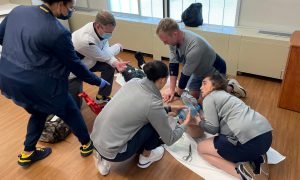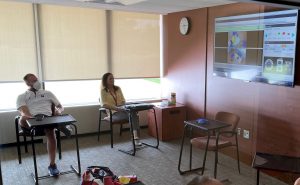
Concordia University Ann Arbor’s nursing and athletic training education departments facilitated an emergency care simulation for the University of Michigan athletic medicine team on Monday, May 17, 2021.
Taking place in CUAA’s Center for Simulation and Innovation (CSI) at Concordia’s North Building (7475 Plymouth Road), 34 athletic trainers, social workers, and team physicians from the University of Michigan athletic department navigated four scenario-based simulations.

The purpose? To practice teamwork and skills needed for the emergency management of likely situations that could occur within the athletic medicine profession such as manual CPR, wound packing, orthopedic injury management, exertional heat injury, head injuries, and much more.
“We were glad to welcome our fellow health care providers into our facilities and learn alongside one another with each scenario,” said Tim Neal, Concordia’s program director of athletic training education and assistant professor of health and human performance.
Two Ann Arbor universities, one partnership
Neal says the simulation exercise is another part of Concordia’s continued relationship with University of Michigan. Members of Michigan’s athletic medicine team have come to CUAA’s classes to present specialized knowledge in spine injury management with athletic training students and staff.
They have also served as preceptors for CUAA athletic training students as they perform clinical rotations, and recently hired Daniela Perez, MSAT, AT, ATC (’20), a member of the first cohort to graduate from CUAA’s master of science in athletic training program. Perez serves as the athletic trainer for the University of Michigan Cross Country and Track and Field teams.

Each of the simulations was intricately planned by University of Michigan athletic medicine and executed by Concordia Ronald and Marvel Jones School of Nursing and athletic training faculty and staff.
Concordia Center for Simulation and Innovation
The state-of-the-art simulation center, complete with high fidelity manikins, volunteer actors, control rooms, fully functioning medical tools, and necessary medical equipment and supplies, was a fitting space for four fast-paced rotations including 15 minutes of the simulation followed by 20 minutes of debrief.
“Simulation is a proven, highly effective teaching and learning modality, not only in the educational setting, but also in the practice environment,” said Anita Simmons, director of simulation and inter-professional education. “Even after learning the proper skills, it still takes practice to function in a timely and efficient manner as part of a team in an emergency situation.”
A simulated scenario example
Below is a taste of the simulated scenarios, allowing the athletic medicine professionals the chance to use effective and timely communication, inter-professional practice, and crisis management skills to have the best possible patient outcome.
Scenario: It’s a 54 degree day at the men’s lacrosse field. You (athletic trainer) hear commotion and coaches yelling your name
Patient #1 (live actor)—took a hard shot and was hit at the same time as he took the shot, bleeding from under his helmet (forehead laceration)
Patient #2 (manikin, Goalie)—prone; unresponsive; no pulse; no breathing
Teammates and coaches state that it didn’t seem as though he saw the shot and the ball hit the goalie in the left chest; state the goalie shook his head 2‐3 times, took two (2) steps forward, and then fell face first

Upon the conclusion of the simulation, the groups would gather in a debriefing room and watch video of the situation they just encountered. The medical professionals were able discuss what went well and what they may have perhaps done differently.
Neal says Concordia plans to continue partnership with University of Michigan athletic medicine to provide simulation-based trainings at Concordia.
Want in? Learn more about Concordia’s Ronald and Marvel Jones School of Nursing, athletic training, and health and human performance programs.
— Rachel Thoms served on Concordia University's Strategic Communications team from 2015-2022. Any inquiries about this story can be sent to news@cuaa.edu.
If this story has inspired you, why not explore how you can help further Concordia's mission through giving.